|
FAQs about Marine Worms, Vermiform Animals
Identification 3
Related FAQs: Worm
IDs 1, Worm IDs 2, Worm IDs 4, Worm
IDs 5, Worm IDs 6, Worm IDs 7, Worm
IDs 8, Worm IDs 9, Worm IDs 10, Worm
ID 11, Worm ID 12, Worm ID 13, Worm ID
14, Worm ID 15, Worm ID 16, Worm ID
17, Worm ID 18, See
Also: Flatworm ID 1 +,
Nemertean, Proboscis, Ribbon Worm ID
1, Nematode, Roundworm ID
1, Nematomorpha, Horsehair Worm ID
1, Acanthocephalans, Thorny-headed Worm ID
1, Tubeworm/Featherduster ID
1 +, Bristle Worm ID 1 +,
Hirudineans, Leech ID 1, Sipunculids, Peanut Worm ID 1, Echiuran Worm ID 1, & FAQs on:
Worm Behavior, Worm Compatibility, Worm Selection, Worm
Systems, Worm Feeding, Worm Disease, Worm
Reproduction, & Invertebrate
Identification, Worms 1, Worms 2, Worms
3, Flatworms/Planaria,
Fire/Bristleworms,
Related Articles: Worms,
Featherduster Worms,
|
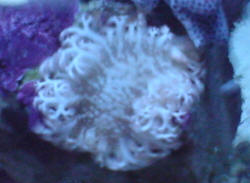
|
What are these worms? More punctuation issues
>hi, first, thank you for a terrific site!!!!!!!!!!!!!!
>>You're welcome, and we're asking everyone who writes in
to *please* use proper punctuation (capitalization of "I",
capital letters beginning sentences, third grade stuff) as these go
into our site's archives. Being all-volunteer crew, we rarely have
time to retype queries. >now my question:
>>Indeed. >I have tiny whitish cream colored worm like
creatures on my glass, my 125gal salt tank. they remind me of inch
worms but a lot smaller and don't move like them. do you have any
idea if these are harmful to my fish ??? >>I'm sure
they aren't, and could be any one of thousands of possible
creatures. >I know you don't have a magic ball but I
thought maybe you might have a slight idea and tell me something that
will make me feel better.. thanks in advance for your help,
Caryn >>I'm sure they're not harmful, and are
likely food for those fish that might like to eat them. Such is to be
expected when keeping saltwater fishes, especially if making use of
good (and sometimes even not so good) live rock. Marina
| The worm that 8 Goniopora 4/4/04 Crew of
Wonders, <wondering in Pittsburgh, Anthony Calfo in your
service> In my 175 reef I have a Goniopora, healthy and BIG for
about 5 1/2 months now. I acquired it before I was to bask in the
collective knowledge of WWM. I now know better. <good to hear,
as they say "Every day, a better way"> But over the
last 2 days it has been closed with little extension; I figured it
was the beginning of the inevitable. As I was preparing the pyre, I
noticed what looked like an arm of a serpent star entwined
throughout the stubs and "flowers" of the Goniopora. I
noticed that MY serpent star was across the tank so I tried to grab
it with a pair of tongs. It looked about 4 inches long as it
meandered around the coral. As I touched it recoiled swiftly. After
3 tries I got the bugger and placed it in a container. It has
contracted to about 1 1/2 inches and swimming with a
"sine" movement. It also "slimed" the water
when I messed with it, a whitish discharge that floated on the
water. Attached is a small pic of the suspect, to the left you can
see the goo it oozed. Any insight would be appreciated,
especially if it was the culprit of the Goniopora's ills. I
searched the FAQs and no mention of the goo... Walter <I cannot
make a specific ID for this worm or even confirm that it is
predatory or simply scavenging an already (albeit suddenly, dying
or necrotic Goniopora. I can say that is it is the former, it did
not likely arrive on import with the coral, but rather appeared
recently from the introduction of a coral, love rock, snails, sand,
etc without a proper quarantine period. Hard to explain a decided
predator any other way with 5+ months of good behavior. Kindly,
Anthony> |
|
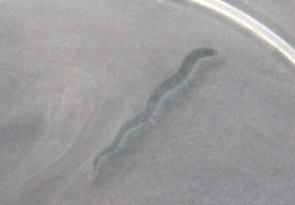
|
Encrusting Calcium Worms Hello Crew,<Howdy!> I recently
added a nice piece of Fiji rock to my tank, has sprouted some sea
squirts coco worms and some clam or oyster, perhaps a scallop as it is
still small and clear hard to tell.<Awesome!> What I am wondering
about is I have noticed from time to time what appears to be sand or
small round particles being ejected from the rock. I now have what
appears to be small white curls growing on the back and sides and now
on the front of my aquarium, They are really tiny and only with the use
of a magnifying glass was I able to tell they curled. any ideas
of what this may be as I do not even know what to look for in a
search.<I call them encrusting calcium worms because I can't
remember the real name for them. They are harmless and are a
common sighting in most aquariums.> also if you know what they are?
should I be concerned?<See above! No need for
concern. Cody> Thanks, Drew
Worms II Hello Cody,<Howdy!> Thank you for your reply ,
I found what I was looking for , they are more then likely Spirorbidae
from the family of Serpulidae and says they are a sign of a maturing
tank, this is good then.<Yeppers!> One question I can not seem to
find a solid answer on is the ideal temp, Specific Gravity, and PH,
also what about calcium of I think KH??? I do not have corals yet, I do
have some polyps and inverts, and some feather dusters etc... read
below . My LFS says temp 75-76 with SG of 1.023 -1.025 with ph around
8.3 another LFS say same temp but SG that high will stress fish out and
cause disease. another say higher temp but lower SG in the range of
1.021-1.022 and temp of 80.<I prefer temp at 78-80 and SG as
1.025-1.026 this is about what oceans are at if you take a average.>
right now I have my temp at 76 with SG of 1.023 and PH 8.2 is this good
bad in the middle? My fish seem healthy and active and eat well, also
my inverts are very active.<Yes this is fine, but maybe on your next
water change increase the SG a little but no more than .001 at a
time.> Thanks
Drew
|
Hold The Sauce- It's Just A Spaghetti Worm!
Good Morning - <Hello there! Scott F. with you
today!> Below are several pictures of hitchhiking
organisms in my tank. My tank is rather small (45 gallons) and
has been up and running for approx. 1 1/2 years. The 1st 3
pictures are of a worm of some type that I've had in my tank
for most of the time I've had the tank. It used to only show
up at night (dark) and would retract when exposed to light. It
would appear to come out of the LR and I was/am not concerned
about it since it does not appear to be causing any problems.
Recently though, it has changed. It now comes out at all hours
and it appears to have a central point that all of the appendages
come from - almost appearing to be a calcareous tube. It has and
continues to get larger and with more worm like appendages. I
keep the tank fairly clean and clean out the skimmer often to
keep excess nutrients to a minimum. I also have several stars and
other scavengers to keep the detritus to a healthy level. Is this
a Medusa worm and is there anything I need to know about it or be
concerned about? It does not appear to be a segmented worm.
<To me, it appears to be a Terebellid Worm, more commonly
known as a "Spaghetti Worm", typically of the genus
Eupolymnia or Loimia. Interesting and harmless; I wouldn't
worry about 'em...Enjoy the diversity> The last
picture is of what I thought was a sponge but I now am
questioning that it is not some form of polyp - the picture may
not be clear enough to make a distinction. Several of these have
developed in my tank in various areas and are actively growing.
They all appear spherical in nature, are different sizes and are
actively growing. Any clue? <I couldn't make a good
call on that one. Would it be possible to send a more clear pic?
Thanks!> Thanks - Love your site. J.T. Craddock
<Thanks for the kind words, J.T.- enjoy the unique creatures
that are popping up in your tank! Regards, Scott F.>
|
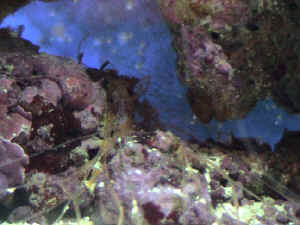 |
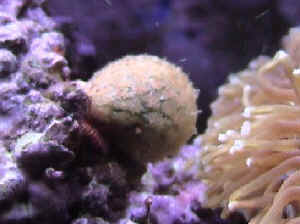 |
| Worm ID 3/26/04 Hello Crew: My 45 SW system
has been up and running trouble free for about 9 months now. About
90% of my insight and direction has been from this website, and
Calfo and Fenner's amazing Reef Inverts book. I
thank you so much for everything. <your success is our
impetus> Tonight I noticed a little worm hiding in a sweet cave
in one of my larger rocks. I can only see about 3 inches
total of it in the opening of the cave feeling
around. It looks like it is black and white striped
width wise, not length wise. <tough to discern from
the pic (distance/clarity of the image) but is does sound like it
could be the browsing of a Sipunculid peanut worm (hobby-common
species are often striped as such)> It's body almost seems
telescopic in nature, and has a tiny circular ending (almost looks
like a mouth of some sort). I hope the pic I am
including is visible enough to see. Any info would be
great on this little guy! Steve <best regards, Anthony> |
|
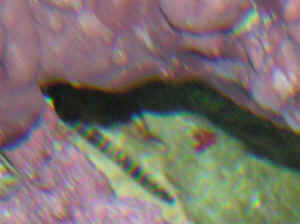
|
| Algae and Worm Identification
3/26/04 Hello Anthony! <cheers Thanassis> Could you pls
help me identify the algae in the picture? I believed it to be
Dictyota, since I saw a photo in your book "Reef
invertebrates", where it looks like the Gracilaria. <the
photo is not clear, my friend, but it does appear to be like
Dictyota> Secondly, I noticed just yesterday the very thin and
black striped worms getting a part of their tentacles out of a hole
in the LR. Firstly I thought they were the feet of a brittle star,
but them I realized they came out from two different holes in the
LF. Can you identify it? <alas, no... nothing discernible
here> Sorry about the bad quality of photos. Thanks, Thanassis
<kind regards, Anthony> |
 |
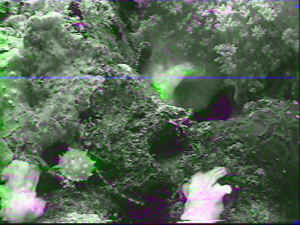 |
Worm Worries (3/23/04) <For future reference, please
capitalize the proper noun "I" and try to use punctuation in
your inquiries. We post all queries and replies permanently on our
site, so they need to be as readable as possible. Our volunteer staff
will have much more time to answer queries if they don't have to
spend time fixing grammar. Thanks.> I just started a
small saltwater tank and its been running for about 5-6 weeks. All of
my fish are great but anyway I just bought a turbo snail and put it in
my tank (after quarantine of course). My 5 gal q tank showed no signs
of this worm intruder but my main tank has a 2 cm worm it looks like a
very tiny and pale leech. It doesn't much like light and when i
went at it with a tweezers it squirmed into my live rock. Do you think
it is bristleworm larvae or some other thing. PLEASE get back to me on
answer A.S.A.P, thanks for your time. Aaron <Not a larva, but a
juvenile bristle worm. Truth be told, bristle worms usually do more
good than harm. Read the bristle worm FAQs for all the info you need.
Hope this helps, Steve Allen.>
| Harmless flatworm- eats copepods 3/23/04
Greetings Crew! Hope everyone is doing
great. <with hope for you in kind my
friend> Can anyone ID the critter in this photo? It
kinda "pulses" as it traverses the
glass..... Thanks! Brad <the creature is a
harmless flatworm that preys on micro zooplankton. Its presence is
a very good indication that you have excellent and uncommonly
strong populations of copepods likely. They wax and wane naturally
in the aquarium in an inverse predator-prey relationship. Enjoy :)
Anthony> |
|
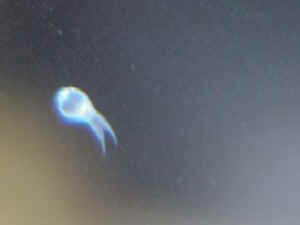
|
Strange worms in California about a foot long and really
skinny! I found a bunch of worms that looked like squirming skinny
strings. they are less than a 16th of an inch in diameter
and one was almost a foot long...they were slender and their diameter
was constant from one end to the other...it didn't even seem like
they had a head or anything. do you have any idea of what it
is?? They were found in Poso Creek in California in the
County of Kern...they were in the leaves along a sandy creek that just
started to run....I can send a photo if you want me to... Thanks, Sam
<Please do send a pic... Do these worms have any apparent bristles
or other identifying structures? Is there a definite banded area near
the "head" end? Sounds like some sort of Oligochaete to me (a
setae-less annelid/segmented worm) which does not narrow this down
much. Same group as the common "nightcrawler, earthworms,
Tubifex... Bob Fenner>
Re: strange worms in California about a foot long and really
skinny! thanks so much for the quick response! After I had sent you
the question i found out what it was later...it's common name is
the "horsehair worm".....some have been found up to two feet
long I guess... they have an incredibly interesting life
cycle......sort of scary actually! Thanks for the help and take care
Sam <Neat! The phylum Nematomorpha... not often seen. Thanks for
sending this update. Bob Fenner>
| Worms ID? Pictures included Dear Anthony
and crew, <Hey there> Last night I noticed one of the worms
in my tank moving around a Turbo snail that has not acted
"normal" for the last week. We took the enclosed photo
and then got a probe out and started poking around. The worm was
definitely eating the snail. I am a little worried since I have
several other critters in the tank that I don't want the worm
to eat (T. crocea, Nudibranch, another snail, and a cleaner
shrimp). I have seen the worms quickly find the shed casing from
the shrimp and eat it but the worms never seem to try to get
anything that was alive and well. If this is just normal activity
for a non harmful worm then that is fine. If this is a worm that
needs removal I am ready to try that too. I looked in your book but
could not decide what to call this worm. He is very stretched out
in this photo. He appears to have been about seven inches in
length. He was as you can see very stretched. After removal of the
snail shell he snapped back abruptly and disappeared into the rock.
This was about an hour after the halides had turned off and 30
minutes after the VHOs shut down. Joel PS Enjoying both of your
books. Thanks so much for the hard work put into them. <Joel...
from your description and pic I would definitely remove this
worm... too big and predaceous to be trusted. Watch your hands on
the "podia" structures (the furry things on the sides) as
these are likely very sharp, possibly venomous. Bob Fenner> |
|
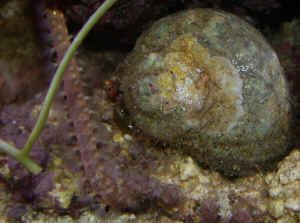
|
| Unknown White String Thing.. still unknown
2/24/04 Hey Crew <howdy> Hope all is well. I
have a 35 gallon hex with a Fluval 404, Bak Pak skimmer and a 96
watt PC 50/50. I have 2 Perculas, 1 Coral Beauty, 1
cleaner shrimp, A small open Brain, a scallop (I know you
disapprove, but I take good care of him), 8 margarita snails, a
couple hermits and a sand sifting star. Ph 8.2, Ammonia
0, Nitrites 0, Nitrates 10, Temp 80. My question is
regarding white hair like stings that have shown up in my tank over
the last week. I have read through every FAQ I can find
but have not found anything that answers my question. I
have attached a few pictures for you. Sorry for the
quality, a hex tank makes it hard to get close up pictures, so I
had to enlarge them. They are primarily on the glass but
I do have some on the LR. They are stationary (or if
not, none of them have moved) and appear to just lifelessly wave in
the current. I am not even sure if they are
alive!! At first I thought some sort of snail excrement
or eggs, but there are to many and they are about 1mm thick and
1.5" long. My only thought is that they are some
sort of worm or ectoproct. I have not seen a negative
effect on the system, but that does not mean they are
harmless. I appreciate your help! Have a great day!
Scott <alas... the pics are low res and a blur. Nothing we can
see from here. It would not be surprising if it were a worm though.
Do send a better pic if you can in time. Read more on polychaetes
in the archives until then or beyond. Kindly, Anthony> |
|
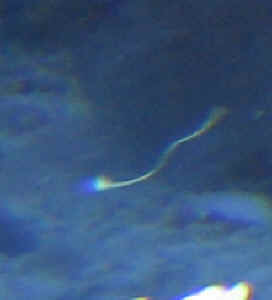
|
|
A Wacky Worm! Dear Crew: <Hi there! Scott F. here
today!> Hello again! Just a quick ID here if it is
not too much trouble. I tried to keep the
.Jpg size as small as possible:-) I just ordered 50lbs
of NANO size Marshall Island rock. I placed the rock
in a couple small QT tanks so I can make sure of it before adding
to my already settled main display tank without any problems.
<Excellent procedure!> On day 2, this little thing made
its' way to the front of the glass. Any ideas what
it could be? Thank you so much in advance for all of your help!
Steve <Well, Steve- it looks to me to be a Sipunculid,
commonly known as a "Peanut Worm" (Now, ask yourself-
does that thing look like a peanut to you?). They are fairly
common on South Pacific rock, and are essentially harmless
detritivores or suspension feeders. It will eventually settle
back into the rock or substrate if it is healthy. They do best in
situations where supplemental "feeding" systems, such
as refugia, are connected to the main tank, or where you have a
thriving reef system. Enjoy this oddity! Regards, Scott F>
|
|
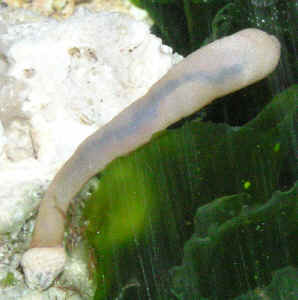
|
|
|

